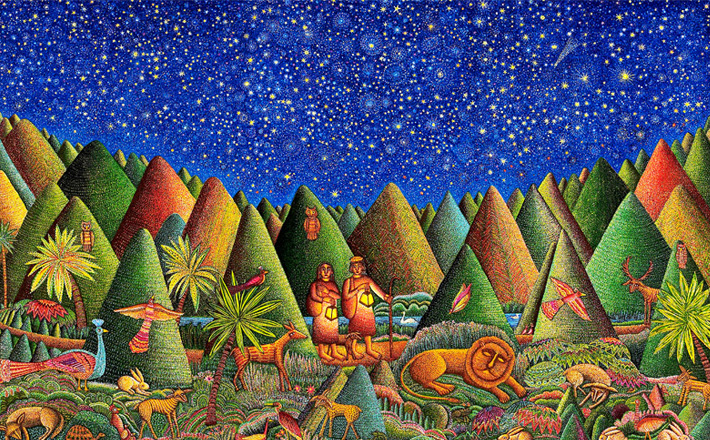Commentary on Overview of NL Year 2
[This overview was co-written by Karl N. Jacobson and Rolf A Jacobson.]1
The Year of Mark: “God at the Center”
Year 2 in the Narrative Lectionary’s (NL) four-year cycle is the Year of Mark. This means that from the Christmas season through Easter, Gospel readings will come from Mark. In the fall, as in every year, the preaching texts come from the Old Testament, sampling the story of Israel’s Lord from creation in the garden (Genesis 2) through the return of the exiled Judeans from Babylon.
Narrative Lectionary users have asked for help dividing the year into smaller worship series. In response to that request, we have taken a stab at that task. Remember, the worship series below are only suggestions and are not meant to be binding.
We suggest that one way to frame the whole of Year 2 is to use the theme “God at the Center.” That theme is taken from this year’s “David story” — in which David moves the Ark of the Covenant to Jerusalem, thereby placing God at the physical center of the new capital and thus placing God spiritually at the center of the nation.
Each year, the Narrative Lectionary features at least one key David story. This is so because, other than the Gospel narratives about Jesus, the story of King David is the longest account of a person’s life in the Bible. David’s story runs from 1 Samuel 16:1 to 2 Kings 2:12, thirty-one and a half chapters long. From his time as a shepherd boy anointed king in private, to his victory over the giant Goliath, to his battles with Israel’s enemies and Israel’s first king (Saul), to the Bathsheba affair.
One of the more important things which David did, and that is less familiar to many of us, is told in 2 Samuel 5-7. David brought the Ark of the Covenant — which contained the tablets of the Ten Commandments, and was the seat upon which God sat in the presence of the people in the tent of meeting — and established it in Jerusalem. Before this the Ark was mobile, sojourning with the people as they crossed the Red Sea, wandered to and fro in the wilderness, and as they finally made their way across the Jordan into what would become Israel. Even with the people settled in the Promised Land, the Ark was meant to be moving about, back and forth, among the tribal territories of Israel. That is, until David brought the Ark to Jerusalem once and for all. (2 Samuel 5:1-5; 6:1-5 is the reading for Oct. 20, 2019.)
What is important about this move, particularly as the narrative of Israel’s history is laid out in the Historical Books, is that it centralized Israel’s worship and devotion; it placed God at the center of the nation, the people. It was there, in Jerusalem (and under the reign of David’s son Solomon, in the Temple), that God’s name was invoked, cherished, and honored by the Israelites “with all their might, with songs and lyres and harps and tambourines and castanets and cymbals” (2 Sam 6:5).
This may seem a minor thing. But in bringing the Ark to Jerusalem David was embodying the obedience to the first “table” of the Law: establishing God alone as Israel’s God; honoring God’s name and ensuring that it might be called upon properly; remembering the Sabbath.
David brought the Ark into Israel’s center, its heart, in worship. In so doing he set God at the center of the people.
This theological claim, that God belongs at the center of the nation of Israel, and so at the center of the church, and the life of faith, is a fitting theme for the fall lectionary series. We have divided the fall readings into several thematic series, each of which may be fruitfully explored under the overall theme of life with God at the Center.
The theme of “God at the Center” is also helpful in framing the Gospel of Mark. The keynote thematic verse for the Gospel of Mark is sounded in 1:15, as Jesus returns from his time of testing in the wilderness and speaks his first words: “The time is fulfilled, and the kingdom of God has come near; repent, and believe in the good news.”
The story of the Gospel of Mark is the story of God coming into “the center” in Jesus the Christ. Jesus announces that the kingdom of God has come near — and that kingdom is Christ himself. Most particularly, the kingdom of God is Jesus as he is crucified, dies, and rises from death in victory.
Year 2 Suggested (not Required) Worship and Preaching Series
Here are some suggested — emphasis on suggested — groups of texts into which the fall might be divided into smaller units.
Series I — “I Know You by Name” (4 Weeks)
9/8/19 Genesis 2: Adam names the animals and finds a “life” partner
9/15/19 Genesis 18 & 21: Isaac (“Laughter”) is born to Sarah
9/22/19 Genesis 32: Jacob wrestles with God, his name is changed to Israel
9/29/19 Exodus 1, [2] & 3: God’s name is given to Moses
One element holding the first four weeks together is the theme of names.
Adam (whose name means “earthling”) is created from the Adamah (meaning “earth”). Adam is placed in the garden, where he is given the calling of tending and keeping the creation and naming God’s creatures. But Adam is alone so God created woman, a fit life partner for Adam.
The theme of “names” continues as God turns Sarah’s painful, scornful, disbelieving laughter at God’s promises into the laughter of faith as the promise of Isaac is kept. Jacob, whose name means “heal” or “cheater” has his named changed by God to Israel — one who strives with God and prevails. Finally, in Exodus 2, the unnamed Pharaoh is outwitted by the Shiphrah and Puah, and in Exodus 3, God calls Moses, giving the gift of the divine name.
Series II — “Free at Last! Free at Last!” (5 Weeks)
10/6/19 Deuteronomy 5 & 6: The Ten Commandments
10/13/19 Ruth 1: The fidelity of Ruth and Naomi
10/20/19 2 Samuel 5: David moves the Ark of the Covenant to Jerusalem
10/27/19 1 Kings 12: The Kingdom divides, as the North leaves the South
11/3/19 1 Kings 18: God gives Elijah victory over the prophets of Baal
The next five texts in the fall can be grouped together under the theme of freedom. Having suffered under the bondage of slavery in Egypt, the children of Israel are freed to be in relationship with God — the holy relationship of the covenant between God and Israel.
The Ten Commandments are God’s covenantal freedom. The Decalogue shows how divinely freed people live. The covenantal love that Ruth and her mother-in-law Naomi show each other is another picture of covenantal freedom. In the midst of drought, death and scarcity, they show each other abundantly free love.
David unites the twelve tribes into one kingdom and then moves both capital and the Ark to Jerusalem: putting God at the center of the freed people.
Unity does not last long. The North secedes and in the process “divides” not only the kingdom but the worship of God.
But God remains faithful even in the midst of division, conflict and infidelity from the people. As the people limp along after the false god Baal, God remains faithful to the divine promises — sustaining Israel and breathing life into the remnant of the faithful.
Series III — “A God Who Changes Yet Remains the Same” (2 Weeks)
11/10/19 Hosea 11: “How can I give you up?”
11/17/19 Isaiah 5 & 11: The Peaceable Kingdom
We recommend a two-week series that continues from the time of the prophet Hosea (circa 750-722 BCE) to the prophet Isaiah (circa 738-690 BCE). Here we have two pictures of God. The pictures tell the same old story. God is faithful. The people are not. Because God is a God of justice, God does not ignore sin and violence. God is not indifferent to the suffering of the poor, the innocent who are oppressed. So God judges those who oppress and spill innocent blood. But God also remains faithful to the divine promises. God changes with the times but still remains the same.
The first picture of God comes from Hosea. The challenge here is to preach the whole message of Hosea — and specifically Hosea’s family metaphor. The preaching text focuses on Hosea 11 — the “good news” part of the book, where God the faithful parent says to Israel that God will not give her up. But preach the whole message as best you can. God is a God of justice and also mercy.
The second picture is from Isaiah. Or rather the second two pictures. Picture 2a is the vineyard parable where God says that Israel has the borne the sour fruit of injustice and so will be plucked up. Picture 2b is the promise of the peaceable kingdom, in which predator and prey will lie down in peace together. God is a God of justice and also mercy.
Series IV — Advent and Christmas: “The Way of Peace” (6 Weeks + Christmas)
11/24/19 2 Kings 22: King Josiah’s reformation
12/1/19 Jeremiah 33:14-18 Promise of the Messiah
12/8/19 Isaiah 40: Promising a return from exile
12/15/19 Ezra 1 & 3: Rebuilding the Temple
12/22/19 Luke 1: Zechariah’s Song
12/24/19 Luke 2: The Birth of Jesus
12/25/19 Luke 2: The Birth of Jesus
12/29/19 Mark 1: The Beginning of the Good News
The Advent and Christmas story takes us from the Reform of Josiah, to Exile, to the Return, and the birth of Jesus and coming of John the Baptist.
Most people will not know the story of the reform of King Josiah (c. 620). Good King Josiah seeks to remodel the Temple and is told that an ancient scroll has been found — most likely the core of the book of Deuteronomy. Josiah attempts to reform the people and, like David, put the Lord again at the center of the nation. The reform is intense but in the end fails. If hope for peace is to come, it will have to come from somewhere else.
Hope is renewed in the Exile, as the prophets we know as Jeremiah and Isaiah of the Exile promise that the faithful God will restore Israel to the land. The stories we have here is the commissioning of that promise to preach good news.
After the return, Ezra rebuilds the Temple and again puts God at the center of the people’s life. This is again a faithful attempt to stay true to God. It is also what Advent is about. Finally, the birth of John makes his aged father break his silence and break into song — which is precisely what Advent is about. And so too, the birth of Christ makes all creation repeat the sounding joy of Christmas.
The Sunday after Christmas we transition to Mark, with the announcement of the one who prepares the way. John picks up the promise of Isaiah of the exile and trumpets the coming of the Messiah.
Series V — Epiphany: “The Unveiling of the Christ” (8 Weeks)
1/5/20 – 2/23/20
Series VI — Lent: “Are We Not Disciples?” (5 Weeks)
2/26/20 – 3/29/20
Holy Week, April 5-10, 2020: “Then They Came to Jerusalem”
Series VII — Easter: “Living a life of amazement” (8 Weeks)
4/12/20 – 5/31/20
The stories for this year (Narrative Lectionary 2019-2020) invite us to explore and imagine our day to day with God, with Christ, at the Center of our lives of faith, worship, learning, and service.
Notes
- Commentary adapted from version published on Sept. 6, 2015.


September 1, 2019